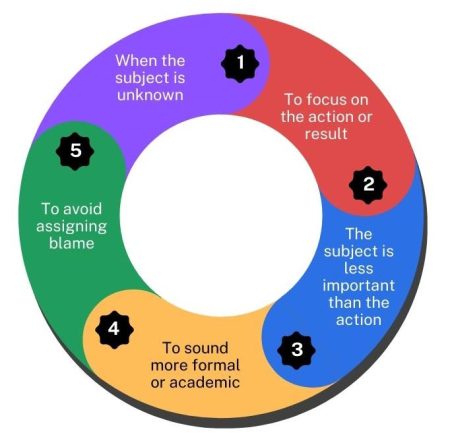Active vs Passive Voice

Active vs Passive Voice
Active voice means the subject does the action. For example, “The cat chased the mouse.” The cat is doing something; it’s active.
Passive voice flips it around, making the action done to the subject. Like, “The mouse was chased by the cat.” It’s more indirect.
While active voice often makes sentences more dynamic, passive voice can be useful too. Let’s explore active vs passive voice.
Active Voice
Active voice emphasizes the subject, the person or thing carrying out the verb. In an active voice, the subject comes first. Then, the verb follows the subject.
Here are some examples of using active voice:
- “The chef cooks a delicious meal.”
- “Lightning strikes the tree.”
- “The artist paints a beautiful picture.”
Each sentence shows someone or something actively doing an action. In this case, it’s using simple tense verbs. They make it clear and straightforward who is performing the action.
Passive Voice
Passive voice is when the action of the sentence is done to the subject. Now, the focus is on the action and what receives it, not who does it.
Using the same sentences as above, here they are in passive voice:
- “A delicious meal is cooked by the chef.”
- “The tree is struck by lightning.”
- “A beautiful picture is painted by the artist.”
Passive voice can make sentences sound formal or emphasize the action more than the subject. It’s also useful in scientific writing or when the doer is unknown. But, it can make things less direct.
Converting Passive to Active Voice
Let’s go through a couple of examples of converting passive to active voice.
Passive = The breakthrough was made by the scientists.
Active = The scientists made a breakthrough.
In the sentence “The breakthrough was made by the scientists,” the big discovery is the main point, not who found it. But, “The scientists made a breakthrough” puts the spotlight on the scientists doing something amazing.
Passive = The bank was robbed by two men.
Active = Two men robbed the bank.
In “The bank was robbed by two men,” the sentence focuses on the bank being robbed, not so much on the robbers. But, “Two men robbed the bank” shines the light on the two men doing the robbing. How you say it switches what part grabs your attention.
Passive = The burglar was arrested by police.
Active = Police arrested the burglar.
Similar to the above, it’s all about what part of the story you want to stand out. “The burglar was arrested by police” focuses on the burglar getting caught. Less focus is on who caught him. On the flip side, “Police arrested the burglar” highlights the police’s action.
When To Use Passive Voice
Most readers prefer active voice for its directness. If possible, that’s why we always encourage you to use it. Although passive voice can be less direct, it’s okay to use passive voice in several situations.
Here are some key ones:
1. When the subject is unknown
It’s okay to use passive voice when you don’t know who performed the action. “The window was broken.” The emphasis is on the event because we don’t know who did it. Another example is, “The car was stolen overnight.” The subject again is unknown.
2. To focus on the action or result
In scientific and academic writing, the outcome or the action itself is more significant than who performed it. “A cure for the disease was discovered.” This emphasizes the discovery of the cure, not the person who discovered it.
3. When the subject is less important than the action
There are times when the action’s impact is more important than who performed it. “The painting was sold for a record price.” Here, the emphasis is on selling at a record price. This can help keep the audience’s attention on the results rather than on the individuals.
4. To sound more formal or academic
The passive voice has a formal tone that suits academic writing, legal documents, and formal reports. “The experiment was conducted according to the protocol.” This style makes the process the focus rather than the researchers.
5. To avoid assigning blame
When wanting to soften the delivery of bad news, passive voice can soften the action. “Mistakes were made.” This approach is less direct and can reduce the perception of finger-pointing.

Active vs Passive Voice
Today, we pointed out the differences between active and passive voice. Active voice means the subject does the action. But passive voice flips it around and the action is done on the subject.
While passive voice can be less direct, it still has its place. We use it when the subject isn’t known and in formal writing. It’s all about using it wisely to suit your message.
Do you have any questions about using the active or passive voice? Please add them to our comment section below. We’ll be happy to get back to you.
